American Dog Tick
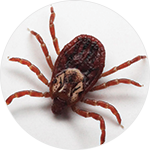 Color: Brown with whitish to gray markings
Color: Brown with whitish to gray markings
Legs: Larvae have 6 legs, nymphs and adults have 8 legs
Shape: Oval, flattened
Size: 3/16” (5 mm) unengorged, 5/8” (15 mm) engorged
Antennae: No
Region: Found throughout the U.S. except the Rocky Mountains area.
The American dog tick gets its name from the fact that adult ticks prefer domestic dogs as hosts, and this tick species is only found in North America.
Habits
It is thought that American dog ticks are attracted by the scent of animals, so they are common along roads and trails. Adult ticks prefer domestic dogs as hosts and can therefore be brought into the structure or home by pets and potentially transferred to humans.
Habitat
These ticks prefer grassy areas with low vegetation where larger mammals pass by. American dog ticks do not survive well indoors.
Threats
The American dog tick is the primary vector of Rocky Mountain spotted fever in the United States. It is also known to transmit tularemia, a rare bacterial infection, and cause tick paralysis.
Prevention
When in an area where ticks are common, wear long sleeved shirts and pants, preferably light colored so ticks will be easy to detect. Tuck pants into socks, and use a tick repellent when outside. To get rid of ticks and limit risks indoors, inspect clothing and skin when heading inside. Wash clothes immediately.
If a tick is found on the body, use fine-tipped tweezers to grasp it as close to the skin’s surface as possible. Pull upward with steady, even pressure. Don’t twist or jerk the tick as this can cause the mouth-parts to break off and remain in the skin. Once the tick is removed, thoroughly clean the bite site with soap and water. Then, flush the tick down the toilet or wrap it in a tissue before disposing in a closed receptacle.
Bald-faced Hornet
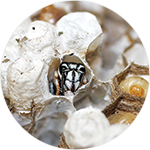 Color: Black with a white pattern on most of the face
Color: Black with a white pattern on most of the face
Legs: 6
Shape: Traditional wasp shaped body
Size: 1/2 – 5/8 inch
Antennae: Yes
Region: Found throughout the U.S.
The bald-faced hornet is a relative of the yellowjacket and gets its common name from its largely black color and mostly white face. This stinging insect is named a hornet because of its large size and aerial nest.
Habits
Bald-faced hornets are social insects, although not true hornets. They live in colonies that may contain between 100 and 400 members at their peak. They usually appear in late summer when populations are largest. Unlike some stinging insects, bald-faced hornets do not reuse their nests season after season.
Habitat
Bald-faced hornets build paper nests at least three or more feet off of the ground, usually in trees, shrubs, on overhangs, utility poles, houses, sheds or other structures. These nests can be as large as 14 inches in diameter and more than 24 inches in length.
Threats
Bald-faced hornets are aggressive and will attack anyone or anything that invades their space. This makes bald-faced hornet removal somewhat difficult. These hornets have slender stingers and do not lose their stinger in their victim’s skin. Each hornet can sting repeatedly. Bald-faced hornet stings also carry venom that makes the stings hurt, itch and swell for about 24 hours. Humans are at the same risk of allergic reactions from bald-faced hornet stings as with other insect stings.
Prevention
If you find a bald-faced hornet nest on your property or home, do not attempt to remove it on your own as this can aggravate the colony and cause the hornets to sting. Contact a pest management professional.
Black Widow Spider
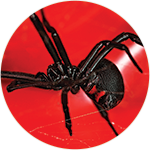 Color: Black, with characteristic red “hourglass” on back
Color: Black, with characteristic red “hourglass” on back
Legs: 8
Shape: Two main body segments
Size: 1 ½ – 1 3/8 inches long
Antennae: No
Region: Found throughout the U.S.
Black widow spiders are most recognized for the red hourglass shape under their abdomen. This spider gets its name from the popular belief that the female black widow spider eats the male after mating, although this rarely happens. Black widows are poisonous when ingested during the first 17 days of their life.
Habits
Black widows are active when the temperature is 70 degrees or higher, but they can survive lower temperatures with the right conditions. Black widow spiders spin irregular webs, which they build at night near ground level. Once complete, these spiders hang upside-down in their webs.
Habitat
Outdoors, black widow spiders commonly live in protected areas like under stones and in firewood piles. They are often found in barns, outhouses and sheds. Indoors, black widows prefer cluttered areas of garages, basements and crawl spaces.
Threats
While male black widow spiders rarely bite, females are known to be aggressive and bite in defense, especially after laying, and when guarding eggs. Symptoms of a black widow spider bite include fever, increased blood pressure, sweating and nausea. Fatalities are unlikely, as long as proper medical treatment is sought in a timely manner. If you notice black widows or signs of infestation, contact a professional immediately for a proper course of black widow spider control.
Prevention
Avoid black widow spider bites by reducing clutter in basements and garages to eliminate hiding spots. When spider webs are visible, use caution before putting your hands or feet in that area. You should also wear heavy gloves when moving items that have been stored for a long period of time and shake out shoes before wearing them. Outdoors, store firewood at least twenty feet from the home and five inches off the ground. If you suspect a spider infestation, contact a pest management specialist immediately. This is the most effective way to get rid of black widow spiders in the structure or home.
Brown Marmorated Stink Bug
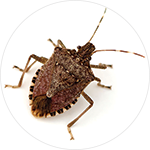 Color: Mottled grayish-brown
Color: Mottled grayish-brown
Legs: 8
Shape: Triangular or shield
Size: 3/4 inch long
Antennae: Yes
Region: Found in the eastern half of the U.S., as well as California, Oregon, Washington, Arizona, New Mexico and Texas
Brown marmorated stink bugs are an invasive species from Asia that arrived in Pennsylvania in 1996. The stink bug earned its name from its tendency to release an odor when disturbed or when crushed. Many other insects have these same characteristics, including some species of ants, beetles and other bugs.
Habits
In general, adult stink bugs feed on fruits and nymphs feed on leaves, stems and fruit. Stink bugs search for overwintering sites in late fall to find shelter from the winter weather. They reemerge in early spring and become active.
Habitat
Adult stink bugs occasionally enter homes and other structures when searching for overwintering sites. During warm months, they often congregate en masse on the sides of structures or homes.
Threats
Stink bugs have the potential to spread throughout the country, which could be harmful to the agricultural industry, as they destroy crops. Although stink bugs are not known to bite humans, their tendency to invade structures or homes in high numbers can be a nuisance. They can cause concern when they get into packaging materials and other goods inside food plants.
Prevention
To prevent stink bugs from entering homes and buildings, seal cracks around windows, doors, siding, utility pipes, behind chimneys, and underneath the wood fascia and other openings. Use a good quality silicone or silicone-latex caulk. Damaged screens on doors and windows should be repaired or replaced.
Brown Recluse Spider
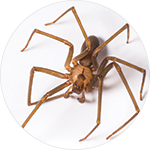 Color: Light to dark brown, with characteristic dark brown violin marking on back
Color: Light to dark brown, with characteristic dark brown violin marking on back
Legs: 8
Shape: Two main body segments
Size: 1/2 – 1/4 inch long
Antennae: No
Region: Found in the south central Midwest from Ohio to Nebraska and south through Texas to Georgia
Brown recluse spiders have a characteristic dark brown violin marking on their back. These spiders often infest cedar shake roofs and spin irregular webs.
Habits
Brown recluse spiders are nocturnal and eat other small bugs like cockroaches and crickets. These spiders spin irregular webs, which are not used for catching prey but rather as a retreat.
Habitat
Brown recluse spiders often live outdoors where they are typically found around rocks, utility boxes and woodpiles. Indoors, brown recluses can be found in any undisturbed area, such as inside boxes, among papers, in seldom-used apparel and shoes, under furniture or in crevices of window moldings. Closets, attics, crawl spaces and basements are the most common brown recluse spider hiding spots.
Threats
Like the black widow spider, the brown recluse spider bites in defense and does not bite humans instinctively. However, both female and male brown recluse spiders can bite and inject venom. The brown recluse’s bite is usually not felt, but results in a stinging sensation followed by intense pain as long as six to eight hours later. A small blister may develop at the bite location that can turn into an open ulcer. Fever, rash, nausea or vomiting and joint pain are some of the additional symptoms associated with the bite of this spider.
Prevention
To avoid brown recluse spiders in known areas of infestation, do not leave clothing on the floor. Store clothing and shoes inside plastic containers, and shake out all clothing that has been in a hamper before wearing or washing.
Cellar Spider
 Color: Pale yellow to light brown or gray
Color: Pale yellow to light brown or gray
Legs: 8
Shape: Long skinny legs with a small body
Size: 1/2 – 3/8 inch long
Antennae: No
Region: Found throughout the U.S. and Canada
Long-bodied cellar spiders have very long, thin legs and as their name implies, they are found in dark and damp places like cellars and basements. There are about 20 species of cellar spiders in the United States and Canada.
Habits
Cellar spiders seem to fare better in areas with higher relative humidity. These spiders build loose, irregular, tangled webs in corners, and hang upside down on the underside of them. The webs are not cleaned but rather new webs are continually added. This habit can result in extensive webbing in a relatively short time. When disturbed on its web, the cellar spider has the habit of rapidly shaking its body in a rotary movement to confuse and entangle the prey.
Habitat
Long-bodies cellar spiders and their webs are usually found in dark and damp places, such as cellars, basements, and crawl spaces. They can also be found in the corners of garages, sheds, barns and warehouses, on eaves, windows and ceilings, and in closets, sink cabinets and bath-traps.
Threats
Cellar spiders do not pose a threat to humans, as their weak mouthparts keep them from injecting venom into humans.
Prevention
To keep long-bodied cellar spiders out, seal cracks on the outside of the structure or home, especially around doors and windows, and use screens to prevent entry. Using yellow light bulbs for exterior lighting may reduce the number of cellar spiders and other insects, as they are typically attracted to white-light sources. Additionally, lowering the humidity in basements, cellars and crawl spaces with the use of a dehumidifier or ventilation can discourage cellar spiders from living there.
Earwig
 Color: Dark brown
Color: Dark brown
Legs: 6
Shape: Long, narrow
Size: 5/8 inch
Antennae: Yes
Region: Found throughout the U.S.
Earwigs got their name from the myth that they crawl into sleeping people’s ears and tunnel into their brains. The long cerci, or forceps, on their backsides easily identify an earwig.
Habits
Earwigs hide during the day and feeds on leaves, flowers, fruits, mold and insects at night.
Habitat
These insects live together outdoors in large numbers. Earwigs can be found under piles of lawn debris, mulch or in tree holes. They gain entry to a structure or home through exterior cracks. Earwigs tend to be more common in years when there is heavier rainfall in the summer.
Threats
Earwigs do not spread diseases, but their menacing appearance can be alarming to a business or homeowner.
Prevention
Remove harborage sites such as leaf piles, mulch piles or other vegetation. Seal cracks and crevices well to prevent structural entry for optimal earwig control.
Flea
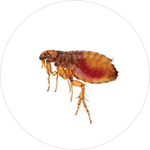 Color: Dark, reddish-brown
Color: Dark, reddish-brown
Legs: 6
Shape: Flat
Size: 1/12 – 1/6 inch long
Antennae: Yes
Region: Found throughout the U.S.
Fleas are parasites that feed on the blood of any warm-blooded body. The most common species is the cat flea, which often feasts on cats, dogs and humans.
Habits
Fleas can live for about 100 days during which time the females produce 400-500 offspring. Fleas transport themselves on rodents and other mammals, and the adult flea usually remains on the host. These pests use their powerful legs to jump as high as 8″ vertically, which is 150 times their own height. If humans could do this, we would be able to leap over skyscrapers.
Habitat
Fleas infest both household pets and wild animals like opossums, raccoons and skunks. They can also be found on shoes, pant legs or blankets, which can transfer the fleas to new environments.
Threats
Fleas are the most common transmitter of bubonic plague. Although cases in the U.S. are rare and most commonly associated with ground squirrels in the western U.S, they also transmit the bacterial disease murine typhus to humans through infected rats. Their saliva can cause serious flea allergy dermatitis in pets and their debris has been reported to cause similar allergic reactions in humans. Fleas can also transfer tapeworms and cause anemia in pets, which is why active flea management is an important component of pet care. Flea bites commonly cause painful, itchy red bumps.
Prevention
Homeowners should clean and vacuum frequently to help remove flea populations and prevent the laying of eggs. It’s also necessary to keep the lawn groomed to avoid rodent habitation. Pet owners should practice active flea management by keeping dogs on a leash when outside, bathing and grooming pets regularly, visiting a veterinarian annually, and using flea treatments according to direction.
House Cricket
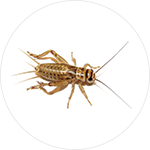 Color: Yellowish brown with 3 dark cross bands on head
Color: Yellowish brown with 3 dark cross bands on head
Legs: 6
Shape: Long, winged as adults
Size: 3/4 – 7/8” inch long
Antennae: Yes
Region: Found throughout the U.S. and world
House crickets get their common name from the fact that they often enter houses where they can survive the winter. They are known for their loud chirping which is made by rubbing their wings together.
Habits
House crickets are nocturnal or active at night and usually hide in dark warm places during the day. Outside, they feed on plants and dead or live insects, including other crickets. Indoors, house crickets can feast on fabric, eating large areas, leaving holes.
Habitat
During warm weather, house crickets typically live outdoors and are especially fond of areas with moisture and warmth. They are often attracted to electric lights in larger numbers, sometimes by the thousands, and rest on vertical surfaces such as light poles and house walls. However, when cold weather approaches, they seek shelter in houses and sheds because of the moisture and warmth they provide.
Threats
Clothing and carpets can become damaged when house crickets enter homes. They typically feed on the surface, leaving the area roughened from pulling the fibers loose while eating.
Prevention
The most effective way to get rid of crickets is to reduce areas of moisture in and around the structure or home. Mow the lawn, weed plant beds and move woodpiles away from the structure. Provide adequate ventilation in crawl spaces, basements, etc. In addition, change outdoor lighting to less-attractive yellow bulbs or sodium vapor lamps. It is also important to seal possible points of entry for house crickets around the structure, including window and door frames. If found indoors, vacuums can be used to remove.
Mosquito
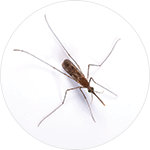 Color: Varies; mostly gray with white, silver, green or iridescent blue scales
Color: Varies; mostly gray with white, silver, green or iridescent blue scales
Legs: 6
Shape: Narrow, oval
Size: 1/4 – 3/8 inch long
Antennae: Yes
Region: Found throughout the U.S.
One of the best-known summer pests, mosquitoes breed in stagnant water or soft soil. There are about 170 different kinds of mosquito species in North America alone.
Habits
Mosquitoes hunt for food by detecting body heat and the carbon dioxide humans exhale. However, only female mosquitoes suck our blood. Male mosquitoes feed on plant nectars.
Habitat
Mosquitoes can breed in any form of stagnant water, including ponds, marshes, floodwaters, storm drains, old tires and water in tree holes. Adults often rest in vegetation during the day.
Threats
Mosquitoes are vectors of numerous diseases including malaria, yellow fever, dengue fever, encephalitis and West Nile virus – a disease that has become a serious concern in the U.S. in recent years. Signs of West Nile virus include common flu-like symptoms. In extreme cases, symptoms include high fever, head and body aches, worsening weakness, confusion and even coma. Use of mosquito repellents when participating in outdoor activities can reduce the risk.
Prevention
Mosquito control begins with eliminating areas of standing water around the property such as flowerpots, birdbaths, grill covers and temporary pools. Keep windows and doors screened if left open for ventilation purposes. Another mosquito management tip is to minimize outside activity between dusk and dawn when most species are active. Use an insect repellent containing DEET on exposed skin and wear long pants and sleeves to prevent mosquito bites when outdoors.
Paper Wasp
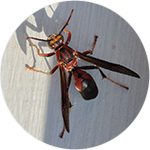 Color: Brownish with yellow markings; a few species with reddish markings
Color: Brownish with yellow markings; a few species with reddish markings
Legs: 6
Shape: Traditional wasp shape with pinched waist
Size: 5/8 – 3/4 of an inch long
Antennae: Yes
Region: Found throughout the U.S.
Paper wasps get their common name from the paper-like material out of which they make their nests. Paper wasps are sometimes called umbrella wasps, after the shape of their distinctive nests.
Habits
Paper wasps are semi-social and live in small colonies. They eat nectar and other insects including caterpillars and flies. In the autumn, inseminated females will seek places to spend the winter, and may find their way indoors, especially if there is a cathedral ceiling present.
Habitat
Paper wasps hang their comb nests from twigs and branches of trees and shrubs, porch ceilings, the tops of window and doorframes, soffits, eaves, attic rafters, deck floor joists and railings, etc. One species will build nests inside voids like hollow fence posts, and patio grills.
Threats
While not an aggressive species by nature, paper wasps will sting if they are disturbed or their nest is threatened. Wasp stings are painful and can cause the same risk of allergic reaction as other insect stings.
Prevention
Treatment and nest removal is easiest in early spring when the wasps are first starting to build their nests. Paper wasps can be beneficial and unless they pose a health risk or food safety risk, control may not be warranted. Treat wood fences and deck railings with a repellent oil to deter paper wasps from gathering cellulose from the wood.
Silverfish
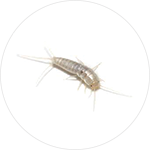 Color: Silver to brown
Color: Silver to brown
Legs: 6
Shape: Oval, elongated
Size: 3/4 inches
Antennae: Yes
Region: Found throughout the U.S.
This insect gets its name from its silvery, metallic appearance and fish-like shape and movements. Silverfish have no wings, but are able to run very fast. They tend to hide their presence from humans which means any damage they have caused could go unnoticed as well.
Habits
Silverfish tend to feed on paper items, glue, clothing and food items, such as flour and rolled oats. Silverfish can live up to a year without food, but require a high humidity environment. They move fast and are typically nocturnal.
Habitat
Silverfish are found throughout the U.S. and are typically seen in moist, humid areas in the home, such as bathrooms, basements, and attics.
Threats
While silverfish are mainly a nuisance pest, they can contaminate food and damage paper goods such as wallpaper and books.
Prevention
Consider a dehumidifier for your home, repair leaky pipes and drains and eliminate or repair any moldy or wet wood. Don’t keep old books and magazines in areas where silverfish are usually found like basements, attics and garages. It’s also important to keep food items such as flour and sugar in tight containers.
Springtail
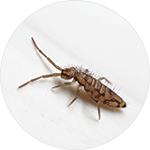 Color: Creamy white to dark brown/black
Color: Creamy white to dark brown/black
Legs: 6
Shape: Segmented, oblong
Size: 1/16 inches
Antennae: Yes
Region: Found throughout the U.S.
Certain species of springtails are referred to as “snow fleas” when found in winter, but they are not fleas at all. Springtails are found year round, but because of a special protein that acts like anti-freeze, this type of springtail is able to survive in cold winter temperatures. Springtails don’t have wings, instead they get around by jumping, using a unique catapult system. Their jumping is especially noticeable in winter when they are contrasted against white snow.
Habits
Springtails are very common around pools with nearby vegetation, around air conditioning condensate drain lines and other moist areas. In winter, snow fleas emerge on sunny days and gather in large numbers around bases of trees where snow has melted. Because of their small size, they look like flecks of pepper or ashes on the surface of the snow. Snow fleas feed on decaying plant matter.
Habitat
Springtails prefer damp soil, leaf mold, decaying logs and fungi.
Threats
Springtails do not cause any structural damage and should not be of concern. In addition, snow fleas are not a threat to family pets as they are not a flea at all. Their sole diet consists of rotting plant food.
Prevention
If you’re looking to get rid of springtails, reduce sources of excess moisture throughout the home or facility. Leaky pipes and standing water are ideal conditions for springtails when the outside weather becomes too cold.
Subterranean Termite
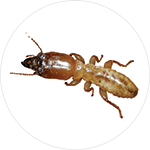 Color: Creamy white to dark brown/black
Color: Creamy white to dark brown/black
Legs: 6
Shape: Long, narrow and oval
Size: 1/8 inch long
Antennae: Yes
Region: Found throughout the U.S.
Habits
Subterranean termites build distinctive tunnels, often referred to as “mud tubes,” to reach food sources and protect themselves from open air. They use their scissor-like jaws to eat wood 24 hours a day, seven days a week. Like other termite species, subterranean termites also feed on products containing cellulose, including paper. Subterranean termites typically swarm in the spring when groups of reproductive termites go off to start new colonies. Winged stages are sometimes confused with winged ants. The wings of ants are of 2 different sizes and ants have a pinched waist. Termite wings are all the same size and the body does not have a pinched waist. The antennae of termites are straight and the antennae of ants are elbowed or bent.
Habitat
Subterranean termites live in underground colonies with as many as two million members. They are also found in moist secluded areas above ground but nests are more commonly located in the soil.
Threats
Subterranean termites are by far the most destructive termite species. The hard, saw-toothed jaws of termites work like shears and are able to bite off extremely small fragments of wood, one piece at a time. Over time, they can collapse a building entirely, meaning possible financial ruin for a homeowner. If you suspect a termite infestation, contact a pest professional about subterranean termite treatment.
Prevention
Certain structural conditions can help to promote termite infestations in buildings. These include wood with a soil contact and improper drainage around structures which allows moisture to soften wood members. Indoors, reduce humidity through proper ventilation of crawl spaces, attics and basements to avoid attracting subterranean termite swarms.
Yellow Jacket
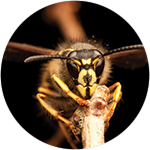 Color: Abdomen usually black and yellow pattered similar to bands
Color: Abdomen usually black and yellow pattered similar to bands
Legs: 6
Shape: Traditional wasp shape
Size: 3/8 to 5/8 of an inch long
Antennae: Yes
Region: Found throughout the U.S.
There are several species of yellow jackets in the United States. These flying insects typically have a yellow and black head/face and patterned abdomen.
Habits
Yellow jackets are social insects that live in nests or colonies with up to 4,000 workers. They become the most problematic for people in late summer and early autumn when the colony size peaks and there are reduced natural food sources for this wasp. Yellow jackets feed on sweets and proteins, and therefore commonly invade outdoor events and can be a problem for food facilities.
Habitat
Yellow jackets can be found anywhere humans are found. They build paper carton nests out of chewed up cellulose, which are usually found in the ground or in cavernous areas such as eaves and attics.
Threats
Yellow jacket stings pose significant health threats to humans, as they are territorial and will sting if threatened. They are known to sting repeatedly and can cause allergic reactions. Yellow jackets and other stinging insects send over 500,000 people to the emergency room each year.
Prevention
Because of their tendency to sting when threatened, yellow jacket control requires specialized equipment and safety precautions. Remove garbage frequently, keep trash cans covered, and ensure all doors and windows have screens that are in good condition. Keep structures well sealed, especially around eaves to prevent interior nesting. People should also avoid wearing sweet-smelling perfumes and the scent attracts yellow jackets. Contact a pest management professional for nest treatments.
